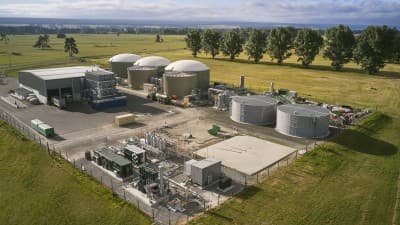When it comes to renewable gases – like biogas, biomethane and green hydrogen – there are plenty of opinions flying around. It’s time to bust a few myths about renewable gas, so here are our top five:
Myth 1: We can and should electrify everything.
Electricity provides a great way to source and distribute renewable energy, especially here in New Zealand where our electrons are already lower carbon than most other countries. While electricity demand will grow in the future, there is a persistent narrative that we can electrify everything and there will be no need for gas. This isn’t true for two main reasons:
First, converting all of our energy demand to electricity would require massive upgrades to our power grid that would be very expensive, and would translate into higher electricity costs. According to the ICCC’s 2019 Accelerated Electrification report, if New Zealand shifted to 100% electricity for all our energy needs, the wholesale cost of electricity could increase by approximately 40%. Also New Zealand’s electricity lines and transmission infrastructure has been built to work together with other energy supply channels – such as liquid fuels and gas. As a result, many of our largest energy users are located in areas that do not have extensive electricity infrastructure. Spreading future energy demand across different sources of supply will continue to be valuable, both in ensuring energy stays affordable and our energy system is secure and resilient.
Secondly, it is difficult to decarbonise process heat through electricity alone. For instance, electricity cannot produce the high temperatures – up to 1,800oC – required for manufacturing products like cement, glass, and steel. Other sectors that are hard to decarbonise with electricity include aviation, shipping, long-distance transport and chemical processing. That doesn’t mean these sectors can’t decarbonise – it just means that they will likely do so by using renewable gas like green hydrogen rather than electricity.
Myth 2: Renewable gas will never be affordable.
Technologies are always expensive until they scale-up. They become cheaper as industries grow, thanks to improving technology, economies of scale and better efficiency. For example, solar panels cost around US$128 per watt in 1975, despite having been invented in the 1880s – now, they cost less than US$0.30 per watt. The cost of electric vehicles is also falling rapidly relative to traditional cars.
Any renewable energy technology we embrace will become more affordable over time and this includes renewable gas. The IEA estimates that biomethane will be 25% cheaper by 2040, and PwC forecasts hydrogen production costs to fall by 50% by 2030. Over the same period fossil fuels are expected to become more expensive as carbon prices rise.
Myth 3: Technical barriers mean renewable gases can’t be used in the gas grid.
Biomethane is just methane derived organic material considered renewable, like food waste. It is chemically identical to the major component of natural gas and can therefore be used in existing natural gas infrastructure without any difference. Also, hydrogen can potentially be blended with natural gas or biomethane at concentrations of up to 20% without any major overhaul of the pipeline network or new appliances for homes.
A pipeline containing 100% hydrogen would need new infrastructure and appliances. That is a driver for Gas Network Ireland’s long term plan to split its network to create two distinct pipelines by 2045: one for hydrogen and one for biomethane. That’s just one of the possible solutions for supplying renewable gas for applications that are difficult-to-decarbonise: allowing us to get renewable gas to our ports to refuel ships, and another form of renewable gas to manufacturing businesses for process heat.
Myth 4: We can’t produce enough biomethane.
Biomethane solves two problems: it takes a waste product (organics) and turns it into valuable renewable resources (gas, CO2, and fertiliser) and it has huge potential to help transition away from fossil fuels and diversify our gas supply.
“Every part of the world has significant scope to produce biogas and/or biomethane,” reports the IEA, “and the availability of sustainable feedstocks for these purposes is set to grow by 40% over the period to 2040.”
Europe is making huge strides in biogas and biomethane, and New Zealand is just starting on its own journey. An independent report by Blunomy and co-commissioned by Powerco, Clarus and Ecogas, confirms that biogas is a ready available energy solution that can contribute to New Zealand's net zero targets and commitments across energy, waste, and agriculture. The study explores biogas development in New Zealand and confirms that the country has the potential to produce up to 23.5 PJ/year by establishing biomethane-producing regional facilities in the North Island.
Myth 5: The gas industry just wants to keep producing fossil fuels.
It is not possible to eliminate use of liquid and gaseous fossil fuels, including natural gas and LPG, from our economy right now. Households and industries have invested in assets that operate on specified fuels, and replacing those assets will be disruptive and expensive. Using our existing networks (both gas and electricity) to deliver an increasing amount of renewable energy will help to ease the transition for consumers, and the gas pipeline is an important tool in that transition.
The gas sector is committed to supporting New Zealand’s decarbonisation goals – and industry players that own natural gas infrastructure are investing in renewable energy generation and distribution. At Clarus, our projects include biomethane production and upgrading, investing in the development of solar generation, as well as research into hydrogen blending in existing pipelines. Clarus is a member of the Climate Leaders Coalition (CLC) of New Zealand and is one of many organisations around the country committed to reducing its emissions.
To learn more about how Clarus is supporting the transition to a net carbon neutral New Zealand, visit Future of Energy.





